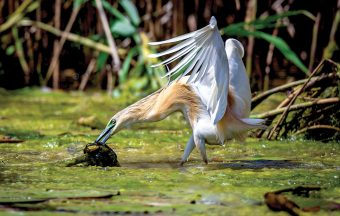All birds have, through evolution, adapted to specific environmental conditions – temperature, precipitation patterns, seasonal changes, and the availability of food. This complex ecological framework that enables their survival is now rapidly being disrupted under the influence of climate change. The increase in average temperature acts like pulling a thread from a carefully woven fabric: once that balance is disturbed, the entire ecological network begins to unravel. To what extent birds in Serbia are affected by these processes, why they are endangered, and whether society sufficiently recognizes the need for their protection was explained to us by Uroš Stojiljković from the Bird Protection and Study Society of Serbia.
– Almost every summer, we witness apocalyptic scenes, and even now, as we speak, images are circulating of the Gruža reservoir, which, due to drought, has reached a record low water level. It is an Important Bird Area (IBA), significant as a migratory corridor and a wintering site for birds, where nearly 200 species have been recorded. This means that breeding birds are left without nesting sites and conditions, food availability decreases, and the physical condition of both parents and chicks is impaired, which is particularly risky for migratory species, says our interlocutor.

He points out that birds, faced with unfavorable changes in their habitats, may attempt to find areas with better conditions. However, this opens a whole new set of challenges — a greater number of individuals are forced to share limited resources, face new competitors and predators, as well as diseases to which they are not adapted.
At the same time, many migratory birds, such as swallows, are arriving earlier each year, which makes them vulnerable to sudden weather changes. Last year, there was a mass die-off of urban swallows in Vojvodina, caused by a sudden cold spell at the end of summer, for which the young birds were unprepared. Climate disruptions, accompanied by increasingly frequent and destructive extreme events, also leave tragic consequences for other species. White storks are particularly threatened, as their nests on utility poles are exposed to strong winds and storms, resulting in significant losses every year. There are many such examples, and it is difficult to list them all, but they all share the same cause – the destabilization of the natural rhythm on which birds have based their survival for centuries.
Although it is impossible to single out climate change as the only factor behind the disappearance or drastic decline of certain species, it further complicates already existing threats such as poisoning, habitat alteration and loss, poaching, electrocution, and collisions.
IN FOCUS:
- Smart Farmland Protection – An Innovation by Young People from Mostar
- Apples as a Sustainable Alternative to Animal Leather
- Danube4all – Restoring Danube Floodplains for the Benefit of Nature and People
123 Endangered Species in the Red Book of Birds of Serbia
For species already endangered, climate change further reduces the chances of recovery. An illustrative example is the critically endangered eastern imperial eagle, whose population has been slowly recovering over the past eight years thanks to intensive protection measures. However, the adverse effects of climate change on this species are becoming increasingly evident in the field. Old trees suitable for nesting, which are already scarce in Vojvodina, are increasingly perishing due to prolonged droughts, weakening their structure. At the same time, solitary trees are being toppled by strong winds and extreme weather events. Such events directly destroy nests or displace chicks, further endangering an already fragile population.
According to the Red Book of Birds of Serbia, as many as 123 bird species are listed as endangered in one of the categories, which testifies to the scope of the problem we are facing.
In Serbian legislation, there are no explicit provisions pointing to specific measures that need to be applied to preserve natural values, biodiversity, or birds in the context of climate change. – That part of the legislation is clearly lagging behind, as is much else in the field of environmental protection, says our interlocutor.
Prepared by Milena Maglovski
The story was published in Energy portal Magazine CLIMATE CHANGE

